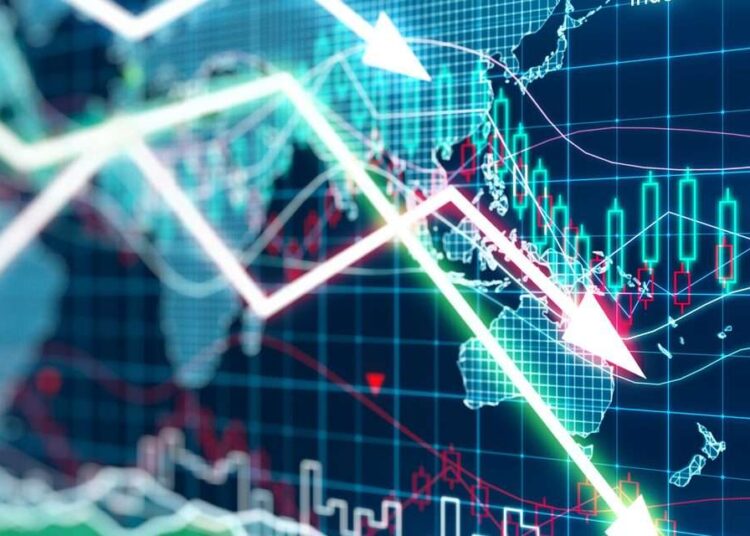The global economy is a dynamic, interconnected web, constantly reshaped by forces that ripple across continents and industries. In this new era, understanding and adapting to global economic shifts is not merely an academic exercise; it is a critical necessity for businesses, investors, policymakers, and individuals alike. From the rise of new technological paradigms to geopolitical realignments and environmental imperatives, these profound transformations are redefining wealth creation, consumption patterns, and the very structure of societies worldwide. This comprehensive guide will delve deep into the multifaceted nature of current global economic shifts, exploring their drivers, implications, and the strategies required to thrive amidst this evolving new reality.
Understanding the Drivers of Global Economic Shifts

Global economic shifts are rarely the result of a single factor. Instead, they emerge from a complex interplay of forces, each exerting its unique influence on the world’s financial and commercial systems. Recognizing these primary drivers is the first step toward comprehending the broader economic landscape.
A. Technological Revolution and Digital Transformation
Perhaps the most potent catalyst for current global economic shifts is the relentless march of technological innovation. The digital revolution, accelerated by advancements in Artificial Intelligence (AI), automation, blockchain, and the Internet of Things (IoT), is reshaping industries, labor markets, and consumer behavior at an unprecedented pace.
A. Artificial Intelligence (AI) and Automation: AI is automating tasks previously performed by humans, leading to increased productivity but also raising concerns about job displacement in certain sectors. It’s transforming everything from manufacturing and logistics to healthcare and customer service. The economic impact is two-fold: significant efficiency gains for businesses adopting AI, and a pressing need for workforce reskilling to adapt to new demands.
B. Digital Platforms and E-commerce: The proliferation of global digital platforms and the explosion of e-commerce have fundamentally altered trade and consumption. Businesses can now reach global customers with ease, but they also face intense competition and the need for robust digital infrastructure. This shift has also impacted traditional retail, necessitating new business models.
C. Blockchain and Decentralized Finance (DeFi): Blockchain technology, underpinning cryptocurrencies, is gradually making inroads into traditional finance, supply chain management, and data security. Decentralized Finance (DeFi) aims to recreate traditional financial services on blockchain, potentially disintermediating banks and other financial institutions. While nascent, its long-term potential for reshaping financial systems is significant.
D. Big Data and Analytics: The ability to collect, process, and analyze vast amounts of data has become an economic superpower. Businesses leveraging big data gain competitive advantages through personalized services, optimized operations, and predictive insights, leading to more efficient resource allocation and targeted marketing.
B. Geopolitical Realignment and Trade Dynamics
Geopolitical developments play a crucial role in shaping global economic flows. The rise of new economic powers, shifts in alliances, and increased protectionism are redefining international trade and investment.
A. Rise of Emerging Economies: The continued economic ascent of nations, particularly in Asia and parts of Africa, is rebalancing global economic power. These economies are becoming not just manufacturing hubs but also significant consumers and innovators, challenging the long-standing dominance of traditional Western economies.
B. Trade Wars and Protectionism: The past few years have seen an increase in trade disputes and protectionist policies (tariffs, non-tariff barriers). While ostensibly aimed at protecting domestic industries, these measures can disrupt global supply chains, increase costs for consumers, and lead to reduced international trade volume, impacting global growth.
C. Supply Chain Restructuring (Reshoring/Friendshoring): Geopolitical tensions and recent global crises (like the pandemic) have highlighted the vulnerabilities of highly optimized, global supply chains. There’s a growing trend towards reshoring (bringing production back home) or friendshoring (locating supply chains in politically allied countries) to enhance resilience and security, albeit potentially at a higher cost.
D. Geopolitical Conflicts and Sanctions: Regional conflicts and international sanctions can have far-reaching economic consequences, disrupting energy markets, commodity prices, and financial stability, often triggering inflationary pressures and supply bottlenecks.
C. Demographic Shifts and Social Transformations
Demographic changes, including population aging, urbanization, and changing labor force dynamics, exert profound influence on economic growth, consumption patterns, and social welfare systems.
A. Aging Populations: Many developed nations, and increasingly some developing ones, face rapidly aging populations. This leads to shrinking workforces, increased healthcare and pension costs, and potential strain on social security systems, impacting public finances and economic dynamism.
B. Urbanization and Megacities: The global trend towards urbanization continues, with a growing proportion of the world’s population residing in cities and megacities. This drives demand for infrastructure, housing, and services, creating both economic opportunities and challenges related to sustainability and resource management.
C. Changing Workforce Demographics and Skills Gaps: Generational shifts (e.g., Gen Z entering the workforce) bring new expectations regarding work-life balance, purpose, and flexibility. Simultaneously, technological advancements are creating significant skills gaps, requiring massive investments in education and reskilling programs to prepare the workforce for future jobs.
D. Income Inequality and Social Discontent: Persistent and, in many regions, growing income inequality fuels social discontent and can lead to political instability. Economically, high inequality can dampen aggregate demand and create barriers to human capital development.
D. Climate Change and Environmental Imperatives
The escalating climate crisis and the imperative for environmental sustainability are no longer just ecological concerns; they are powerful economic disruptors and catalysts for innovation.
A. Transition to Green Economy: The global push towards decarbonization is driving massive investments in renewable energy, electric vehicles, sustainable agriculture, and green infrastructure. This creates new industries, jobs, and investment opportunities but also necessitates the phasing out of fossil fuel-dependent industries, with associated economic challenges.
B. Climate-Related Disasters: The increasing frequency and intensity of extreme weather events (floods, droughts, heatwaves, wildfires) cause significant economic damage, disrupt supply chains, displace populations, and strain public finances for recovery and adaptation efforts.
C. Resource Scarcity: Growing populations and consumption patterns are putting immense pressure on finite natural resources like water, arable land, and critical minerals. This leads to price volatility, geopolitical competition, and the need for circular economy models and sustainable resource management.
D. ESG (Environmental, Social, Governance) Factors in Investing: Investors are increasingly incorporating ESG factors into their decision-making, recognizing that companies with strong ESG performance tend to be more resilient and sustainable in the long term. This is shifting capital towards more responsible and sustainable businesses.
Implications of Global Economic Shifts

These underlying drivers manifest in significant implications across various facets of the global economy, demanding strategic responses from all stakeholders.
A. Reshaping Global Supply Chains and Trade
The drive for resilience, combined with geopolitical factors, is fundamentally altering the architecture of global trade.
A. Regionalization of Supply Chains: Instead of highly dispersed global supply chains, there’s a trend towards more localized or regionalized production networks to reduce vulnerabilities and transport costs.
B. Increased Trade Barriers and Diversification: While some nations push for free trade, others are implementing more trade barriers. Businesses are reacting by diversifying their manufacturing bases and sourcing options to mitigate risks.
C. Digital Trade Dominance: The rise of digital services, intellectual property, and data flows is increasingly dominating global trade, often transcending traditional physical goods trade. This necessitates new international regulatory frameworks.
B. Evolving Labor Markets and the Future of Work
The nature of work is undergoing a profound transformation, with implications for employment, wages, and social structures.
A. Automation and Job Displacement/Creation: While automation may displace jobs requiring repetitive tasks, it also creates new roles in areas like AI development, data analytics, and robotics maintenance. The challenge lies in managing this transition.
B. Skills Gap and Reskilling Imperative: The rapid pace of technological change necessitates continuous learning and reskilling for the workforce. Governments, educational institutions, and businesses must collaborate on robust training programs to ensure workers have the skills demanded by the new economy.
C. Gig Economy Growth: The proliferation of digital platforms has fueled the growth of the gig economy, offering flexibility but also raising concerns about worker protections, benefits, and income stability.
D. Remote Work Revolution: The pandemic accelerated the adoption of remote and hybrid work models, impacting urban planning, commercial real estate, and talent acquisition strategies on a global scale.
C. Inflationary Pressures and Monetary Policy Challenges
Recent global events have highlighted the fragility of price stability and the complexities facing central banks.
A. Supply Chain Disruptions: Global and regional disruptions can lead to shortages of goods and components, driving up prices (cost-push inflation).
B. Energy and Commodity Price Volatility: Geopolitical conflicts, climate events, and demand-supply imbalances can cause sharp swings in energy and commodity prices, with widespread inflationary effects.
C. Central Bank Response and Interest Rate Hikes: To combat inflation, central banks globally have embarked on aggressive interest rate hiking cycles, impacting borrowing costs for businesses and consumers, and potentially slowing economic growth.
D. Debt Sustainability Concerns: Higher interest rates raise concerns about the sustainability of public and private debt, especially in highly leveraged economies.
D. Financial Markets and Investment Strategies
Global economic shifts directly impact financial markets, necessitating adaptive investment strategies.
A. Shift to ESG Investing: Growing awareness of climate risks and social responsibility is driving capital towards ESG-compliant investments, influencing corporate behavior and asset valuations.
B. Volatility and Risk Management: Increased geopolitical uncertainty, inflation, and technological disruption contribute to higher market volatility. Investors need robust risk management frameworks and diversified portfolios.
C. Rise of Alternative Investments: Beyond traditional stocks and bonds, investors are increasingly looking at alternative assets like private equity, venture capital, and digital assets (cryptocurrencies, NFTs) for diversification and potentially higher returns, albeit with higher risks.
D. Impact of Digital Currencies and CBDCs: The emergence of cryptocurrencies and the exploration of Central Bank Digital Currencies (CBDCs) by various nations could fundamentally alter payment systems, monetary policy, and financial market structures in the long term.
Strategies for Navigating Global Economic Shifts
Adapting to and thriving amidst these profound shifts requires foresight, agility, and a willingness to embrace new approaches.
A. For Businesses
Businesses must be proactive in adjusting their strategies to remain competitive.
A. Supply Chain Resilience: Prioritize diversification of suppliers, multi-sourcing, and potentially regionalizing or reshoring critical production to build more resilient supply chains. Implement robust inventory management systems.
B. Digital Transformation Acceleration: Invest heavily in digital technologies (AI, automation, cloud computing) to enhance efficiency, customer experience, and competitive advantage. Foster a culture of digital literacy within the organization.
C. Workforce Reskilling and Talent Development: Develop internal training programs and partner with educational institutions to reskill and upskill employees, ensuring the workforce possesses the capabilities needed for future demands. Focus on critical thinking, problem-solving, and digital fluency.
D. Embrace Sustainability and ESG: Integrate ESG principles into core business strategy, not just as a compliance exercise. This enhances brand reputation, attracts conscientious investors, and can unlock new market opportunities in the green economy.
E. Global Diversification and Market Entry: Explore new growth markets in emerging economies, while also diversifying revenue streams to reduce reliance on any single market or region. Adapt products and services to local consumer preferences.
B. For Investors
Individual and institutional investors must evolve their approaches to protect and grow capital.
A. Broad Diversification: Diversify investments across various asset classes (stocks, bonds, real estate, commodities), geographies, and sectors. Consider incorporating alternative investments (with due diligence and risk assessment).
B. Focus on Long-Term Trends: Instead of reacting to short-term market noise, identify and invest in companies and sectors poised to benefit from long-term global trends (e.g., renewable energy, AI, healthcare innovation, aging demographics).
C. Embrace ESG Investing: Consider allocating a portion of your portfolio to ESG-compliant funds or companies, aligning investments with sustainability goals and potentially achieving resilient long-term returns.
D. Continuous Financial Education: Stay informed about global economic developments, market dynamics, and emerging investment opportunities. Read reputable financial news, follow expert analyses, and consider professional financial advice.
E. Risk Management: Implement robust risk management strategies, including understanding your personal risk tolerance, setting clear investment goals, and regularly rebalancing your portfolio. Avoid over-concentration in speculative assets.
C. For Policymakers
Governments and international organizations have a crucial role in shaping the environment for adaptation and growth.
A. Invest in Infrastructure and Digital Connectivity: Develop resilient physical and digital infrastructure to support trade, innovation, and economic activity in the new era.
B. Education and Workforce Development: Implement comprehensive education and vocational training reforms to equip citizens with future-proof skills. Support lifelong learning initiatives.
C. Proactive Regulatory Frameworks: Develop agile regulatory frameworks that foster innovation (e.g., in AI, blockchain) while mitigating risks and ensuring fair competition and consumer protection.
D. Promote Sustainable Practices: Implement policies that incentivize the transition to a green economy, mitigate climate risks, and promote sustainable resource management.
E. Strengthen International Cooperation: Collaborate on global challenges like climate change, pandemics, and trade disputes to foster a more stable and predictable international economic environment. Resist the urge for excessive protectionism that stifles global growth.
D. For Individuals
Individuals are not merely passive observers but active participants who must adapt to changing economic realities.
A. Invest in Your Skills: Continuously learn and upgrade your skills to remain competitive in evolving job markets. Focus on transferable skills (critical thinking, problem-solving, adaptability) and digital literacy.
B. Financial Literacy and Budgeting: Master personal finance basics: create a budget, build an emergency fund, manage debt, and save for long-term goals. This financial resilience is your first line of defense.
C. Diversify Income Streams: Explore side hustles, freelance opportunities, or passive income ventures to diversify your income sources and reduce reliance on a single job.
D. Build a Strong Network: Cultivate professional and personal networks. Networking can open doors to new opportunities, provide valuable insights, and offer support during times of change.
E. Maintain Adaptability and Openness to Change: The most successful individuals in this new era will be those who are open to new ideas, willing to pivot, and continuously adapt to evolving circumstances.
Conclusion
The global economic shifts underway are profound, multifaceted, and irreversible. They are driven by a confluence of technological breakthroughs, geopolitical realignments, demographic changes, and environmental imperatives. These shifts present both formidable challenges and unprecedented opportunities.
For businesses, the imperative is to innovate, build resilient supply chains, and invest in their human capital. For investors, it’s about diversification, long-term vision, and integrating new asset classes. For policymakers, it’s about fostering inclusive growth, investing in foundational infrastructure, and promoting sustainable practices. And for individuals, it’s about continuous learning, financial literacy, and building personal resilience.
By understanding these dynamics and adopting proactive strategies, all stakeholders can not only navigate the complexities of this new reality but also contribute to shaping a more prosperous, sustainable, and equitable global economy for generations to come. The future is not just happening to us; we are actively building it through our responses to these momentous economic transformations.












